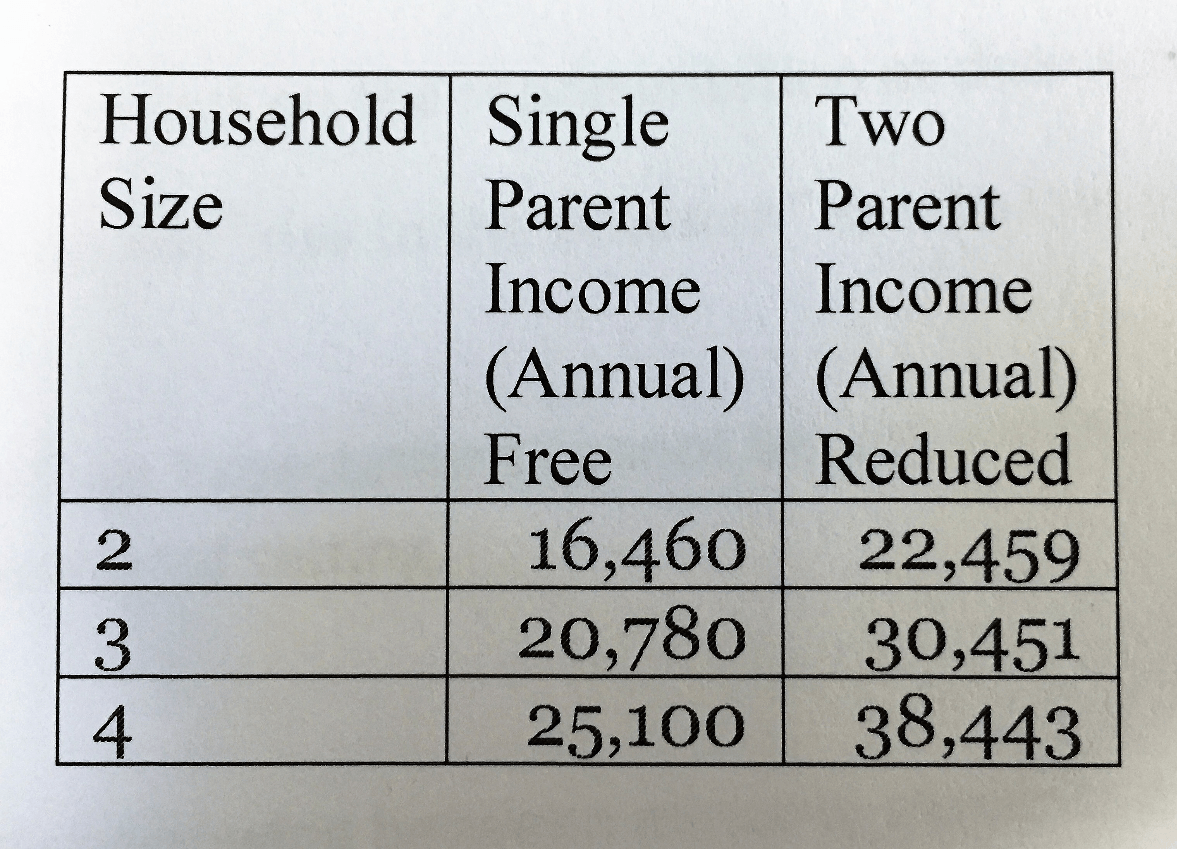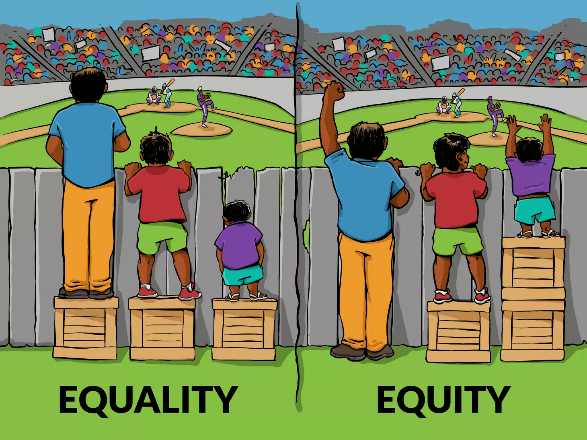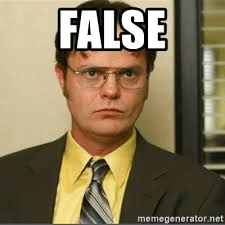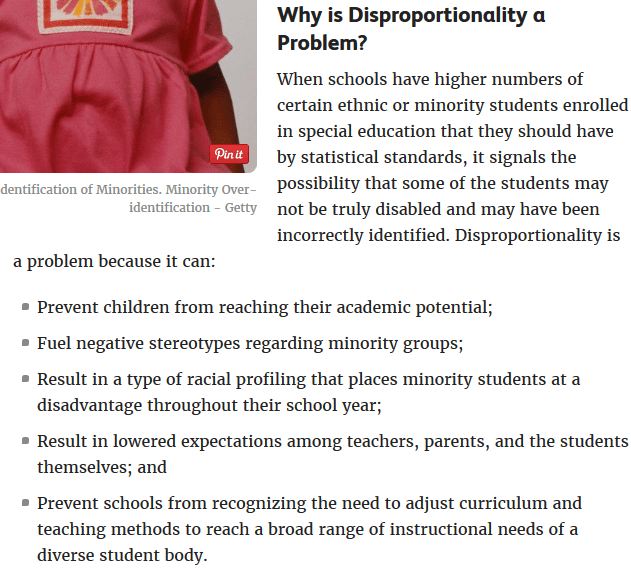According to the Children's Defense Fund, how often is a child born into poverty in the United States?
Every 32 Seconds
Data:
Currently 217 out of 428 total students at the junior high school receive free and/or reduced lunch. This equates to 51% of our school.

Fill in the blanks:
African-Americans, Latinos, Native Americans, and English Language Learners are underrepresented among the top _%, _%, and _% of students at every level of the educational system from Kindergarten through graduate and professional school.
Answer: 1%, 5%, and 10%
Think about your school. Is this an issue at your school? How have YOU been directly involved in getting minority students the representation they deserve?
True or False:
Equality and Equity are synonymous
Answer: False
Equality: The state of being equal, especially in status, rights, and opportunities.
Equity: The quality of being fair and impartial.
True or False:
Education can be considered the great equalizer despite inequalities in terms of race and socioeconomic status.
False
Children at risk, who come from families with poorer economic backgrounds, are not being given opportunities to learn on an equal scale as compared to children from privileged families.
Example: Offering after school tutoring in 7th grade math. While it's equal in opportunity, it is not equal in access to opportunity. It's extremely difficult for single parent homes to schedule time to receive this service.
True or False:
Poor parents are uninvolved in their children's learning largely because they do not value education.
Answer: False
Research: Low-income parents are less likely to attend school functions or volunteer in their children's classrooms because they have less access to school involvement as compared to their wealthier peers. Parents often have less flexibility with their jobs or may even work multiple jobs. Lack of child care and/or transportation also play a role in the lack of parental involvement; however, this DOES NOT mean they do not care about their children's education.
According to the Center for American Progress, what portion of U.S. citizens will live at least one year of their lives in poverty?
Answer: One-third
Data:
One in every three students has or will experience poverty at some point in their educational career. That is approximately 9 students per class given a class of 25.
True or False:
Students, especially minority, often do not "rise to the occasion" due to low expectations from home or school.
Answer: True
Expectations cannot be just a word we use in general conversation. There must be action behind the word itself. What kinds of supports have you established to help students meet your expectations?
A monkey, a goldfish, and an elephant are each given opportunities to climb a tree. This is an example of ____________?
Answer: Equality.
Explanation: "Everybody is a genius, but if you judge a fish by its ability to climb a tree, it will spend its whole life believing it is stupid."
-Albert Einstein
Given evidence that shows that lower socioeconomic students perform lower than their wealthy counterparts, these students are often placed in remedial classes and essential skills diplomas due to
____________ and ___________.
Answer:
Low expectations and teacher bias.
Explanation: "My students could never do this, they won't even bring a pencil to class!"
"I know student X is trying, so I am just going to give them a grade for this assignment."
Fact or Fiction:
Because all ESL students are learning English, they generally all need the same accommodations.
Answer: Fiction
Research: ESL students range in proficiency across four unique language domains: listening, speaking, reading, and writing. Therefore, any accommodations would depend on the student's proficiency level within the language domain required by the learning task.
One in ten white children in the United States is poor according to the Children's Defense Fund. What proportion of Latino children in the United States are poor?
Answer: One in Four
Data:
At JJHS, we have 320 white students to 30 Latino students. 32-White:7-Latino. In a single classroom of 30, that breaks down to a 3:7 ratio.
The achievement gap is significantly narrowing between minority students and Caucasian students. How distant (in points, not percentage) are the minority students from their Caucasian counterparts?
Answer: Trick Question
The achievement gap between minority and Caucasian students has not narrowed. In fact, some studies suggested that the gap is increasing with the primary reason being ______ (Guess).
A mother and her child are eating at a restaurant. The mother's child is given a booster seat, which allows the child equal access to the table. This is an example of _____________.
Answer: Equity.
In an equitable classroom, every student gets what he or she needs.

True or False:
Juan, Demarcus, and Jason are in the same class. Juan and Demarcus are struggling in class due to societal factors. Outside factors shouldn't contribute to the struggles of Demarcus and Juan, and they should keep on pace with Jason.
Answer:
Fact or Fiction:
The term disproportionality is often used when referring to a high number of minority students receiving special education services.
Answer: Fact
Minority students are often over-represented in some areas by statistical standards. this over-representation can lead to:

True or False
Poor children should be treated like English Language Learners because their parents are generally so busy working that they do no have time to speak to or read to their children, which causes them to enter school as language deficient.
Answer: False
Data: Studies have shown that low income and working class families have less developed reading skills; however, there is no evidence that this discrepancy in reading skills is connected to a language use deficiency or that it reflects parental disinterest in education.
What are the dropout rates for African-American and Latino students?
Answer: 6.5-AA, 9.2 -Latino
In a study performed between 2000-2015, the status dropout rate declined from 6.9 to 4.6 for Caucasian, 13.1 to 6.5 for African-American, and 27.8 to 9.2 for Latino students
True or False:
If I differentiate an assessment in the same way for each sudent, I have accomplished equity.
Answer: False
Explanation: You have given each student the exact same thing regardless of individual needs. This is an example of equality.
Tough love on students, especially minority students, is always the answer. Right or wrong?
Answer: Wrong
Students come to us from a variety of places, with a variety of issues. The issues often conflict with what we set as acceptable within a school building. These issues lead to higher suspension rates and tougher than normal consequences against the students.
Mental Health Professionals now play a key role in seeing that students are in a healthy state of being.
My approach: Joe Clark vs. Mr. Rogers = Joe Rogers
Fact or Fiction
Research has found that schools with insufficient professional training for working with diverse students leads to misinterpretations of behavior and more referrals for minority students.
Answer: Fact
How often are minority students sent to the office for trivial matters that could have been resolved with a conversation? To go further, how many students are sent to the office because the teacher or educational professional has not established a meaningful relationship with the student???
Students come to us from all walks of life. Many things are seen as culture when they are in fact, learned behaviors from other people whether the person is a peer, adult, or media.
Sagging, Inappropriate talk, etc.